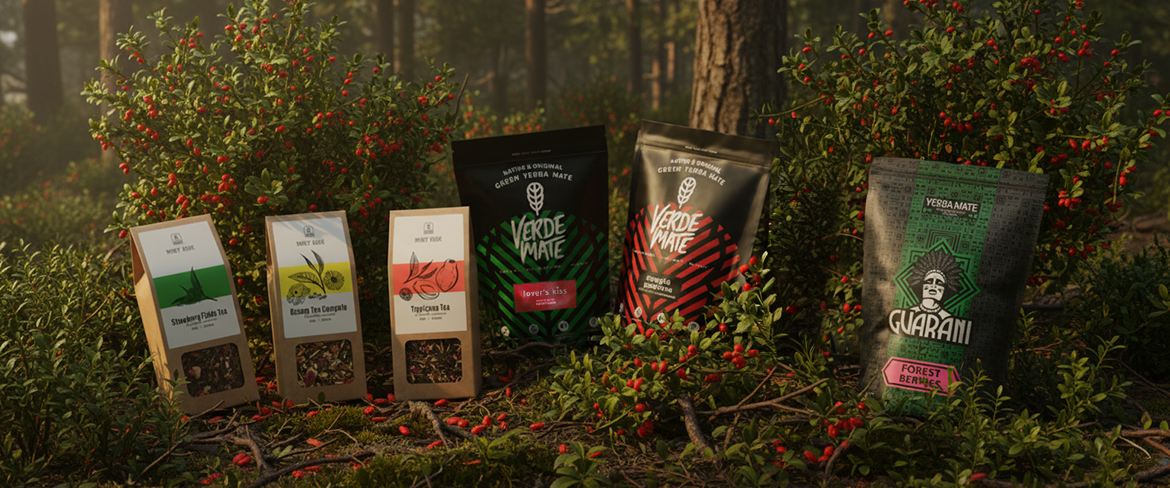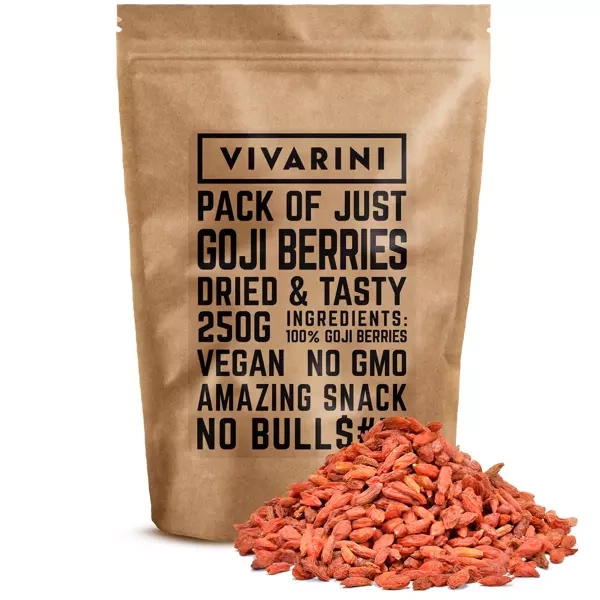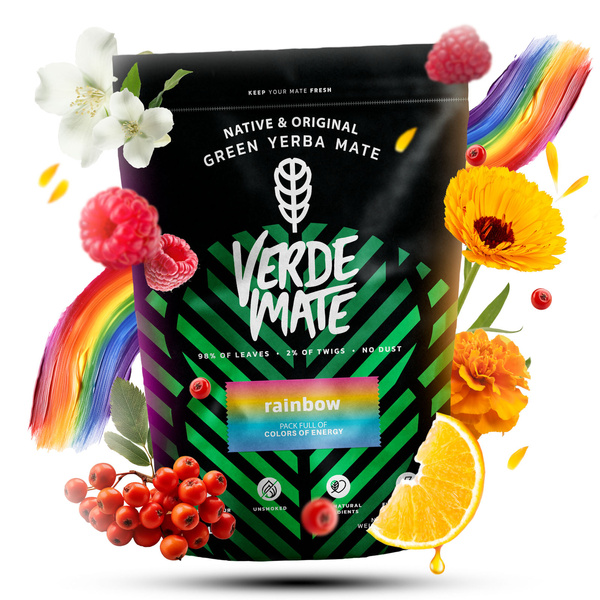Goji berries – what kind of plant is it? What are their properties and how to eat them?

For several years now, goji berries have been making a real splash in the world of natural superfoods and healthy eating. These small, red fruits are packed with an impressive amount of vitamins, minerals and antioxidants, while also offering a distinct flavour – sweet and tangy with a hint of tartness. Interestingly, while in Europe we most often come across dried goji berries, in Asian countries, where they originate, they are often eaten fresh.
So, what exactly is hidden behind the name goji berries, what are their properties and can goji berries be eaten raw? Fresh fruit rarely reaches Europe, which is why we most often choose the dried version. It’s a convenient, fully natural snack that can easily be added to porridge, smoothies, a favourite cup of tea or even a yerba mate brew. What’s more, the drying process means we can enjoy their exceptional properties all year round, whatever the season.
It’s not without reason that they are often called the “red diamonds of health.” In traditional Chinese medicine, goji fruit has for centuries been a symbol of vitality, immunity and longevity. Today, they increasingly find their way not only into home kitchens but also into our favourite teas and even yerba mate blends. In this article, we’ll take a closer look at what goji berries are good for, what nutrients they contain, what the goji berries effects are and the best ways to eat them – helping you to include them easily in your daily diet and take full advantage of their potential.
Summary:
- What are goji fruits?
- Dried goji berries – properties and effects
- Nutritional value of goji berries
- How to eat dried goji berries
- Goji berry side effects and contraindications
What are goji fruits?
Goji berries, also known as the fruit of the Chinese wolfberry shrub (Lycium chinense or Lycium barbarum), are small, red, ellipsoid fruits that grow on shrubs belonging to the nightshade family. This means they’re related to tomatoes and peppers. They come mainly from China, Tibet and Mongolia – areas where they have been cultivated on a large scale for hundreds of years and used both in cooking and traditional medicine.
An interesting fact is that as far back as in ancient Chinese herbals, people wrote about what goji berries are good for – they were said to boost vitality and improve concentration. To this day, in Asian cuisine, goji fruit is used in soups, infusions and teas.
History and popularity
While goji berries have been known in Asia for more than two thousand years, they only gained popularity in Europe and America in the early 21st century. The marketing term “superfood” made them a fashionable addition to a healthy diet. But this is not just a trend – dried goji berries have truly impressive goji berry properties: they are a rich source of vitamin C, B‑group vitamins, iron, zinc and fibre.
Growing and origin
The Chinese wolfberry grows best in dry, sunny climates. The shrubs are small, have thorns and distinctive elongated leaves. Goji seeds are relatively easy to germinate, which is why many healthy‑living enthusiasts try growing their own shrubs in gardens or pots. In practice, however, the most nutritionally valuable fruits come from Chinese and Tibetan crops, where the natural conditions favour full ripening.
👉 Eager to try them straightaway? In our shop you’ll find both dried goji berries and delicious herbal teas and yerba mate blends with goji berries. Later in this article, we’ll share a few specific examples. It’s a tasty way to enrich your daily routine and discover these extraordinary fruits!

Goji berries – properties and effects
Goji berries have long been considered some of the most valuable fruits in the world of natural superfoods. Known for their richness in vitamins, minerals and antioxidants, they’ve earned a permanent place in the diet of those who care about their health and wellbeing. In Europe and around the world, we most often encounter them as dried goji berries – a form that retains most of the nutrients while becoming easier to store and use. In this form, they can be easily added to breakfast oats, smoothies, teas, or enjoyed as a wholesome everyday snack. Importantly, goji berries show remarkably broad goji berries effects, and regular consumption may support the body in many ways.
Dried goji berries – health properties
The popularity of goji berries didn’t appear out of nowhere. Scientific research highlights their rich composition – from vitamin C and B‑group vitamins to iron, zinc and fibre. They also contain LBP polysaccharides, carotenoids and phenolic compounds, which exhibit strong antioxidant activity. That’s why they are often referred to as a “superfood”.
The most frequently studied and described goji berry properties include:
- ✔️ High antioxidant content – the compounds found in the fruits help neutralise free radicals, and laboratory tests have shown significant antioxidant activity. This has made them the subject of research into ageing processes and cell protection against oxidative stress.
- ✔️ Supporting the immune system – the LBP polysaccharides found in them are often mentioned in studies as compounds that may support immune function. In traditional Chinese medicine, goji fruit was used as a vitality booster.
- ✔️ Heart and circulation – fibre, potassium and some bioactive compounds have attracted attention for their potential effect on lipid metabolism and blood pressure regulation. These topics remain under study, but they are often cited in scientific literature.
- ✔️ Vision and skin health – goji berries are a source of zeaxanthin, a natural carotenoid involved in protecting the macula in the eye. Regular inclusion of this compound in the diet has been researched in connection with eye health, while antioxidants also support the skin’s condition.
So, when it comes to goji berry uses and goji berries what are they good for, the potential is wide, and the research continues. It's worth remembering, however, that these fruits should be seen primarily as a food product that works best as part of a balanced diet.
Goji berry medicinal properties
The goji berry medicinal properties have been recognised for centuries in traditional Chinese medicine. It was believed that eating the fruit boosts energy, promotes longevity and helps maintain good overall wellbeing. In Asia, teas, soups and herbal blends containing goji berries are still common today, seen not only as food but also as part of holistic health care.
Contemporary scientists are studying dried goji berries for possible effects on glucose metabolism, liver function and detoxification processes. These are still preliminary findings, and further long‑term clinical studies are needed to confirm them. Nevertheless, what’s certain is that the fruit is a good source of goji vitamins and minerals, making it a valuable addition to the daily diet.
Nutritional value of goji berries
Anyone wondering what can be done with goji berries should know that their main strength lies in their remarkably balanced nutritional composition. Although small in size, they deliver a solid dose of energy and nutrients valued by those pursuing a healthy lifestyle. That’s precisely why dried goji berries are so popularly used as an addition to breakfasts, desserts or hot infusions.
Goji berries – calories and basic nutritional values
Goji berries – how many kcal? 100 grams of dried goji berries provide around 340–360 kcal. That’s relatively little for such a nutrient-packed fruit. Let’s take a look at what’s inside these tiny red powerhouses:
- ✔️ Protein – around 12–13 g/100 g, which makes goji stand out among most fruits. Interestingly, they contain a complete spectrum of essential amino acids.
- ✔️ Fibre – about 10–16 g/100 g, which supports proper digestion and provides a sense of satiety.
- ✔️ Carbohydrates – around 45–50 g/100 g (mainly fructose, glucose and sucrose), which gives these fruits their pleasant sweet‑tart flavour.
- ✔️ Fats – approx. 1.5–2 g/100 g, consisting mostly of unsaturated fatty acids such as linoleic and oleic acid.
Additionally, dried goji fruits are rich in multiple vitamins and minerals, including:
- ✔️ Vitamin C – supports the body’s natural defence mechanisms.
- ✔️ Vitamin A (derived from carotenoids) – important for skin health and vision.
- ✔️ B‑group vitamins – including thiamine (B1), riboflavin (B2) and niacin (B3).
- ✔️ Iron – approx. 6–9 mg/100 g, a value comparable to some red meats.
- ✔️ Zinc, copper and selenium – trace minerals essential for multiple metabolic processes.
Because of this composition, dried goji berries can be seen as a natural “multivitamin” in the diet, though it’s best to enjoy them as part of a diverse, balanced way of eating.
Comparison of fresh and dried goji berries
In Asian countries, fresh goji fruit is often eaten directly, while in Europe it’s chiefly available in dried form. What are the key differences between fresh and dried goji berries?
- Water content – fresh berries contain high moisture, making them perishable. Drying removes water, allowing the fruit to last much longer.
- Nutritional concentration – the drying process condenses nutrients such as fibre, protein and minerals; meaning 100 g of dried berries contains far more nutrients than the same amount of fresh ones.
- Calories – fresh berries are much lower in calories due to their water content. Dried goji berries provide around 340 kcal/100 g, while fresh ones offer only about 70 kcal/100 g.
- Vitamins – vitamin C is sensitive to heat and drying, so its content is typically lower in the dried version than in the fresh fruit.
Ultimately, the choice depends on how you plan to use them. Dried goji berries are convenient, durable and widely available, while fresh ones – though harder to find – can be a delightful culinary addition in regions where they grow naturally. In most European climates, the dried variety remains the most practical and popular form.
📌 Quick summary – dried goji berries:
- ✔ provide about 340 kcal per 100 g
- ✔ contain protein, fibre, carbohydrates and healthy fats
- ✔ are a rich source of vitamins A and C, iron and zinc
- ✔ differ from fresh fruit by a higher concentration of nutrients and far greater shelf life
Both the fresh and dried forms of goji fruit differ in nutrient density and calorie values, but each has its advantages. In the next section, we’ll answer the question how to eat goji berries and show how to combine them with your favourite meals to enjoy their taste and versatility to the fullest.

How to eat dried goji berries?
One of the most common questions among those interested in this superfood is: how to eat dried goji berries and can goji berries be eaten raw? Both questions arise frequently, and the answer is simple – in any way you like! These extremely versatile fruits, with their sweet and tangy flavour, blend perfectly with both sweet and savoury dishes. You can enjoy them as a healthy snack on their own or use them to enrich everyday meals.
Goji berries – how to use them?
Dried goji berries go wonderfully with many simple dishes we prepare daily. If you’re wondering about goji berry uses, here are a few proven ideas:
- Porridge and muesli – a handful of goji berries added to your morning oats is a quick way to elevate your breakfast.
- Yoghurt – a perfect combination of creamy texture and a pleasant tartness from the fruit.
- Smoothies – blending a few berries with your favourite fruits adds colour and a slightly tangy note.
- Baking – cookies, muffins or homemade bread with goji berries gain an interesting flavour and mild sweetness.
- Salads – whether fruit or vegetable salads, dried goji berries add a distinctive taste and a vivid red highlight.
So, when it comes to how to eat goji berries, the possibilities are endless – they can be easily incorporated into countless daily meals without effort.
👉 In our shop you’ll find dried goji berries from the brand Vivarini, available in two convenient pack sizes: 250 g and 1 kg.
What can be made with goji berries in the kitchen?
Beyond adding them to familiar dishes, goji berries are a great base for drinks and healthy snacks. If you’re wondering what else you can make, here are a few tasty inspirations:
- Infusions and teas – simply pour hot water over a few berries to create a light, fruity infusion. They can also be added to tea, yerba mate or herbal blends to enrich the flavour and nutritional profile.
- Healthy snacks – mix dried goji berries with nuts, almonds and seeds to make your own trail mix.
- Desserts – yoghurt bowls, chia puddings, cheesecakes or ice creams – goji berries provide colour, texture and a pleasant tartness.
☕ Teas and yerba mate with goji berries
Another great option is ready‑made blends where goji berries appear alongside complementary ingredients. In our shop you’ll find aromatic teas and yerba mate with goji fruit; a simple and fragrant way to enjoy their flavour every day:
- 🌸 Mary Rose Strawberry Fields – Yunnan green tea with goji berries, rose petals and strawberry.
- 🌺 Mary Rose Assam Compote – Assam black tea with hibiscus, goji berries and marigold petals.
- 🥭 Mary Rose Tropicana – an exotic mix of pu‑erh, papaya, mango, raspberry and goji fruit.
- ⚡ Verde Mate Green Energía Guaraná – energising yerba mate with guarana, goji berries and a hint of orange.
- 💞 Verde Mate Green Lover’s Kiss – a romantic yerba mate blend with strawberry, raspberry, hibiscus and goji berries.
- 🌲 Guarani Forest Berries – an intense yerba mate with goji berries, cranberries and a forest‑fruit aroma.
Thanks to such creative options, you don’t have to limit yourself to eating dried goji berries straight from the pack – you can savour their taste in your favourite drinks and blends that not only taste exceptional but also add a refreshing, exotic touch to day‑to‑day life!

Goji berry side effects and contraindications
Although goji berries are considered a particularly valuable part of a healthy diet, it’s worth remembering that – like many natural products – they may not be suitable for everyone. Before introducing them into your daily meals in larger amounts, it’s best to get familiar with a few important details.
Potential goji berry side effects can occur mainly in individuals who:
- take anticoagulant medications (for example, warfarin) – interactions are possible,
- suffer from high blood pressure and use medication to control it,
- are allergic to plants from the nightshade family, which includes the Chinese wolfberry (the goji plant),
- are pregnant or breastfeeding – data is insufficient, so caution is advised.
In all of these cases, it’s best to consult a doctor before consuming goji berries regularly. It’s a simple rule that helps you enjoy the benefits of superfoods like goji in a safe and responsible way.
❗ Note:
Goji berries may cause side effects only in specific cases, most often due to drug interactions. For the vast majority of people, when eaten in moderate amounts, they are simply a healthy and flavourful culinary addition.
As part of your everyday routine, treat dried goji berries primarily as a nutritious element of a varied, balanced diet. Added to porridge, smoothies or a cup of aromatic tea or yerba mate, they can become a small yet very pleasant enhancement to your daily menu.
This way, we can truly appreciate their culinary versatility and distinctive taste. If you haven’t tried them yet, now’s the perfect time to reach for a pack of dried goji berries or one of our teas and yerba mate blends with goji fruit. Who knows – they might just become your new favourite kitchen staple!
❓ FAQ – frequently asked questions about dried goji berries
1. Can goji berries be eaten raw?
2. How to eat goji berries?
3. What can goji berries be added to?
4. How many calories do dried goji berries have?
5. Are there any goji berry side effects?
Sources of information:
- Wikipedia: Goji.
- M. Antonelli, D. Donelli, Health-Promoting Effects of Goji Berries (Lycium barbarum): A Literature Overview, Biology and Life Sciences Forum, 2024.
- B. B. Vidović et al., Health Benefits and Applications of Goji Berries in Functional Food Products Development: A Review, Antioxidants, 2022.




